1. Introduction
A company’s website contains its personalities, goals, and appeal to its customers, employees, and potential employees. People view a company’s website for more information about the company and its products or services. The information presented to visitors may alter their views on the company and their decisions to work for it or use its products or services [1]. As such, the contents of a company’s website may be critical to its success and revenues.
Fortune 500 is a list of 500 companies in the United States with the highest annual revenues. Businesses worldwide look up to these companies in search of ways to generate as much revenue. Each of these companies possesses websites with varying complexity and content. This paper sets out to find some of the characteristics on Fortune 500 companies’ websites that other companies do not possess—specifically, aspects of a company that are thought to increase its success: MVV statements and DEI policies.
To do this, a sample of Fortune 1000 companies were taken and their MVV statements and DEI policies were collected. Then, chi-squared tests for association for different aspects of the company’s MVV statements and DEI policies with respect to the company’s status as a Fortune 500 company were conducted.
This paper differs from previous studies on company websites, MVV statements, and DEI policies as it explores the intersections. Whereas previous research papers have extensively explored each field, there has not been research that examined the MVV statements and DEI policies that specifically occur on company websites in correlation with companies’ statuses as Fortune 500. The specificity of this subject provides a new perspective on the already comprehensive research conducted on these topics.
2. Literature Review
2.1. Company Website
According to Chun, a company's website "can act as a source of information on products and services for potential customers, job opportunities for potential employees, financial information for potential investors and as a source of general information for the media or the casual browser". The contents and design of the website also help build strong connections between the user and the organization [1]. The importance of a company's website spans beyond a source of information as it affects a company's other operations. As such, aspects of a website can correlate with the company's performance. For example, Vaughan found in 2004 that "the number of inlinks to a company website correlates significantly with the company's business performance measure revenue" [2]. Salehi found in 2012 that "Website information convenience is an important factor for e-commerce success of companies" [3]. A well-designed website is crucial for company success as certain functions may be associated with a company's success and revenues.
2.2. Mission and Vision (M&V) Statements
Mission statements express a company's purpose and ambitions, guide a company's behaviors, and symbolize a company's culture. It further serves as a guide for senior management to come to common terms on company strategy [4]. Visions statements describe the long-run goals of a company, helping company employees and management center their strategies [5]. It is important to possess mission and vision statements as companies achieving success in growth, positioning, and market share have paired their brand positioning with an overarching mission and vision [6].
Previous studies have found differences between mission statement content in higher- and lower-performing Fortune 1000 companies. Williams found that out of 46 companies studied, 42 possessed a mission statement, yielding a 91.3% rate of companies having mission statements. Further, "higher-performing firms included the location, customers, and products or services components more often than lower-performing firms, but the differences were not statistically significant in either case. There was a statistically significant difference where higher-performing firms are more likely to include their economic objective, concern for public image, and concern for employees in their mission statements [7].
Additionally, Chun et al. found many interesting characteristics in the M&V statements of Fortune 500 companies. First, companies in different sectors' mission and vision statements tend to emphasize certain aspects of their company. Companies in the computer, specialist retail, and commercial banking sectors in Fortune 500 overwhelmingly emphasize their competence in their M&V statements. M&V statements are also usually not very accessible on Fortune 500 companies' websites. However, some companies value the accessibility of their M&V on their website more than others, as they direct visitors to their M&V statements on the homepage and make it take up a more significant section of their website [1].
Researchers have also come up with standards regarding good length for M&V statements. For mission statements, an authoritative report states that it should be longer than a sentence but shorter than an essay or report. It should not be too specific to include specific amounts and strategic objectives [8]. There have been reports that disagree on the ideal length for vision statements. Some say that a perfect visions statement should be around 35 words [9], while others think it should be about 11 - 22 words [10].
2.3. Value Statements
Value statements state company values that guide employees’ behavior and drive company strategy. Companies write and publicize their value statements to create a system of behaviors that help achieve company success, signal to stakeholders factors that differentiate the company, and help employees behave in ambiguous and conflicting situations [11]. Previous studies have found that proclaimed company values do not correlate with success [12].
2.4. Diversity, Equity, and Inclusion (DEI)
DEI is an effort around the world to make the workplace more inclusive. As the world becomes more international, workplaces are becoming more diverse. People of different races, genders, sexual orientations, ages, beliefs, practices, customs, etc., are convening in the same workplace to work together. However, due to these differences, many groups are oppressed as they do not fit in with the dominant culture [13].
The ideal case for DEI follows: people from diverse backgrounds collaborate and input their unique and equitable perspectives, leading to more effective problem-solving and innovation, where the company utilizes effective inclusivity [14]. Additionally, hiring a diverse pool of employees means reaching more people, allowing companies to hire the most talented candidates [15]. As such, effective DEI in a company enables the firms to display their high morals values, which attract workers and become more efficient as varied perspectives contribute to better problem-solving.
3. Methods
To test the differences between the MVV statements and DEI strategies on the websites of the top 500 and bottom 500 companies in Fortune 1000, chi-squared tests for association with a significance level of 0.1 were used. First, a simple random sample of Fortune 1000 companies was taken, fulfilling the random condition of the chi-squared tests. Fifty companies were selected not to violate the independence condition of the chi-squared test.
After choosing the 50 companies, the following information from each company was collected: if the company is in Fortune 500, if the company's mission and visions statements are visible on its website, the length of the company's missions and vision statements, if the company's values are visible on its website, the number of value categories, if the company makes statements regarding its DEI policies, and if the company states that it will create more DEI on its website.
Fortune’s 2022 Fortune 100 list was used to collect the ranking of each company. For missions and vision statements, a google search on "(company name) mission statement" and "(company name) visions statement" was first conducted.
For companies with mission and vision statements, these searches usually yielded results for the company's webpage containing their mission and/or vision statements. When the company's website's missions and vision statements did not show up through a google search, the company's website was explored in detail. If the detailed search still yielded no results, it was determined that the company does not possess a public mission and/or vision statement on its website. The M&V statements’ length were collected alongside collecting the M&V statements. In counting the number of words in a company's mission/vision statement, words that do not contribute to describing the company's mission/vision were excluded. For example, phrases such as "our mission is to" and "we uphold a vision of" did not contribute to the length of the company's M&V statements.
To collect value statements and policies for DEI, a similar procedure as missions and vision statements was used. When collecting the number of value categories on a company's website, the webpage containing the values is usually divided into many sections, with nouns as the headers. Figure 1 displays the format in which Target shows its values, per the aforementioned description. For these companies, the number of sections on its website was counted as the value categories—Target possesses three value categories.
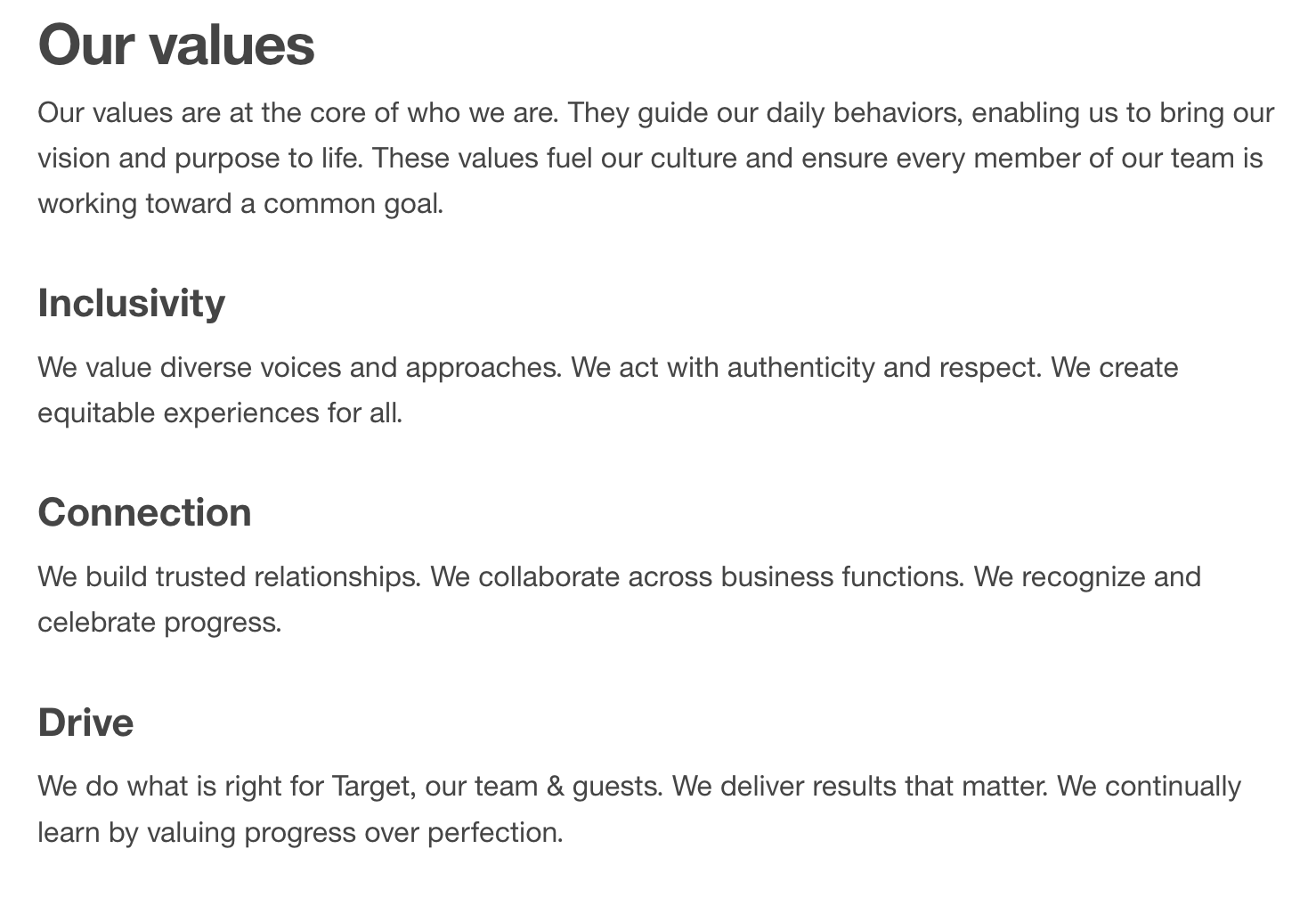
Figure 1: Target website company values page [16].
For other companies, its values were displayed as a list. For example, Whirlpool states that “Our values are the driving force behind everything we do. Respect, integrity, inclusion and diversity, teamwork and the spirit of winning propel our teams to excellence” [16]. For these companies, the number of nouns or noun phrases in the list was counted as the value categories—Whirlpool possesses six value categories.
To collect the company’s policies on DEI, the words diversity, equity, and inclusion were searched on the company’s website. It was determined that a company had plans to improve their DEI if they mentioned their want to improve, the existence of a DEI task force, or policies planned or executed that will strengthen their DEI.
All this information was then used to conduct chi-squared tests with respect to whether the company is in the top or bottom 500 of Fortune 1000.
4. Results
4.1. Preliminary Findings
86% of Fortune 1000 companies display mission statements on their websites. Visual comparisons of the difference in the inclusion of mission statements between the top 500 companies and the rest are displayed in Figure 2. Excluding the companies that do not display their mission statements, the median length of mission statements is 11 words, while the median becomes 10 when the companies that do not display their mission statements are included as 0-word mission statements.
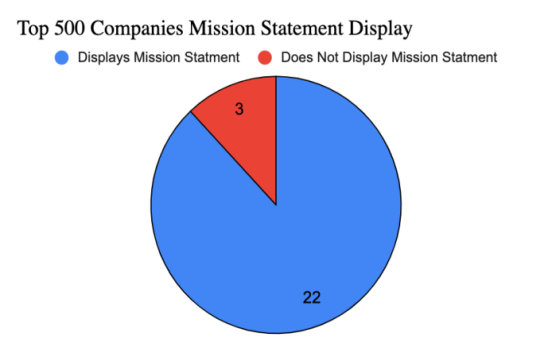
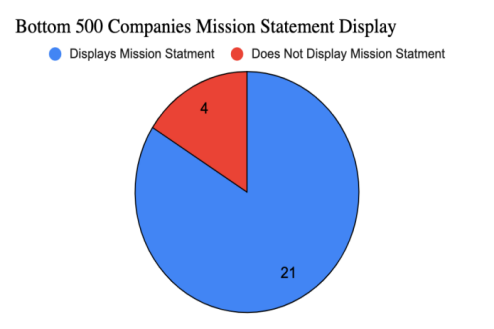
Figure 2: Top 500 companies sampled mission statement display (left). Bottom 500 companies sample mission statement display(right).
Interestingly, only 52% of Fortune 1000 companies display vision statements on their website. Visual comparisons of the difference in the inclusion of vision statements between the top 500 companies and the rest are displayed in Figure 3. Excluding the companies that do not display their mission statements, the median length of vision statements is 13 words, while the median becomes 14 when the companies that do not display their mission statements are included as 0-word vision statements.
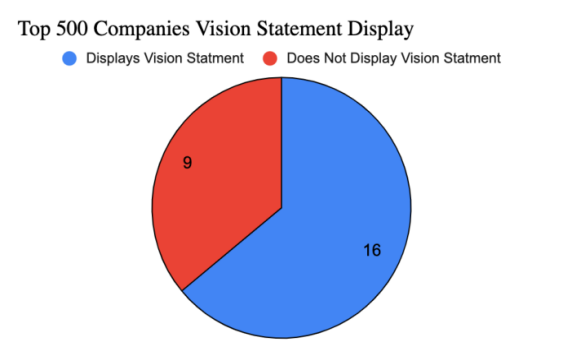
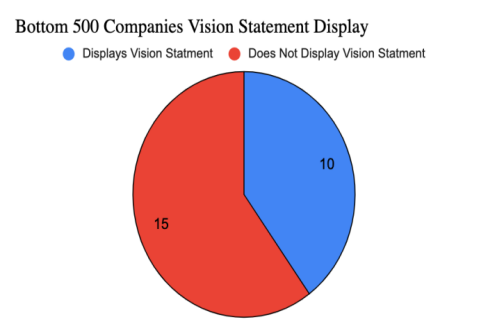
Figure 3: Top 500 companies sampled vision statement display(left). Bottom 500 companies sampled visions statement display(right).
74% of Fortune 1000 companies address their values on their website. Visual comparisons of the difference in the inclusion of value statements between the top 500 companies and the rest are displayed in Figure 4. Excluding and including the companies that do not display their values on their website yielded the same result of a median of 4 values.
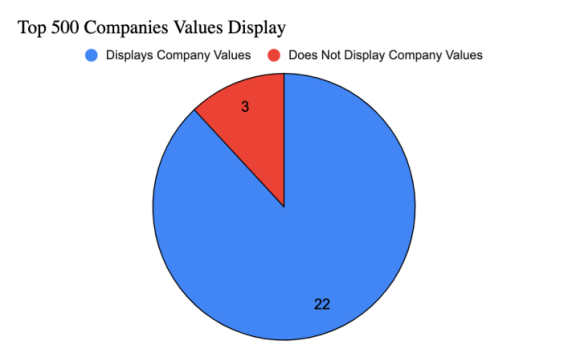
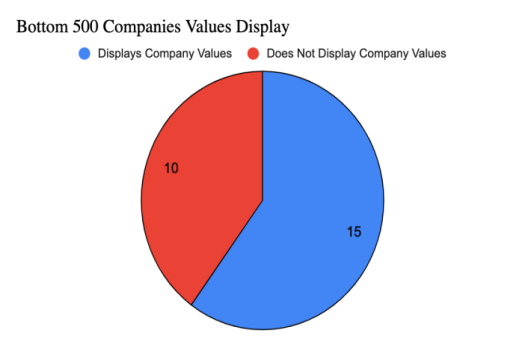
Figure 4: Top 500 companies sampled values display(left). Bottom 500 companies sampled values display(right).
For the DEI statements on the companies’ websites, 96% mention diversity, 62% mention equity, and 96% mention inclusion. The sampled companies always mention diversity and inclusion in pairs, while they sometimes leave out the equity component. 64% of the sampled companies mention that they want to improve their DEI policies. Visual comparisons of the difference in mentioning the improvement of DEI policies between the top 500 companies and the rest are displayed in Figure 5.
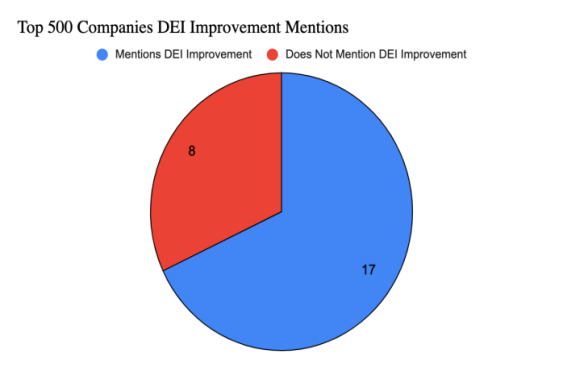
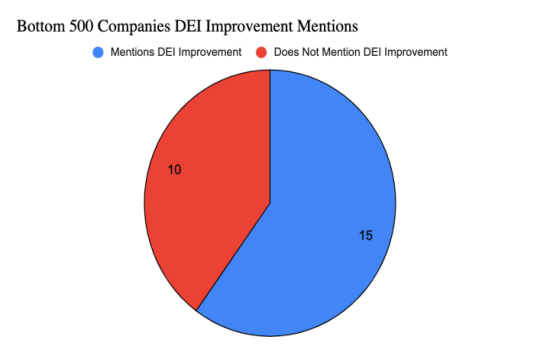
Figure 5: Top 500 companies sampled DEI improvement mentions (left). Button 500 companies sampled DEI improvement mentions (right).
4.2. Results of the Chi-Squared Test
Chi-squared tests for association at a significance level of 0.1 for the aforementioned categories yielded four statistically significant results: the inclusion of visions statement on the company website, length of visions statement, inclusion of value statements on the company website, and number of value categories.
Table 1: Chi-squared results for companies’ inclusion of visions statement on their website.
Includes Vision Statement | Excludes Vision Statement | X^2 | 2.884615385 | |
Top 500 Companies | 16 | 9 | df | 1 |
Bottom 500 Companies | 10 | 15 | p-value | 0.08942935903 |
Table 1 displays there is evidence that the top 500 companies in Fortune 1000 are likelier to include visions statements on their company’s website.
Table 2: Chi-squared results for companies’ visions statement length with companies that do not possess a visions statements counted as having a length-0 visions statement.
Vision Statement Length greater than Four | Visions Statement Length less than or equal to Four | X^2 | 2.884615385 | |
Top 500 Companies | 15 | 10 | df | 1 |
Bottom 500 Companies | 9 | 16 | p-value | 0.08942935903 |
Table 2 displays there is evidence that the top 500 companies in Fortune 1000 are likelier to possess a visions statement that is greater than four words. This result may be due to the abundance of companies that do not possess vision statements on their websites. The median visions statement lengths for the sampled top 500 companies is 8 words, while its 0 for the bottom 500. However, the range of the vision statement lengths for the bottom 500 companies is much greater. The maximum vision statement length for the sampled top 500 companies is 30 words, while its 146 words for the bottom 500.
Table 3: Chi-squared results for companies’ inclusion of values on their website.
Includes Company Values | Excludes Company Values | X^2 | 5.093555094 | |
Top 500 Companies | 22 | 3 | df | 1 |
Bottom 500 Companies | 15 | 10 | p-value | 0.02401491276 |
From Table 3, there is evidence that the top 500 companies in Fortune 1000 are likelier to state company values on their website.
Table 4. Chi-squared results for companies’ value categories with companies that do not state their values counted as having 0 value categories.
More Than Three Value Categories | Less Than or Equal to Three Value Categories | X^2 | 4.15959253 | |
Top 500 Companies | 19 | 6 | df | 1 |
Bottom 500 Companies | 12 | 13 | p-value | 0.04139936223 |
Table 4 displays there is evidence that the top 500 companies in Fortune 1000 are likelier to display more than three company value categories on their website. Because of the abundance of companies, this result may also do not state company values on their website. The median number of company values for the top 500 companies is 4, while its 3 for the bottom 500.
5. Conclusion
Although there are disparities between the top 500 and bottom 500 companies in Fortune 1000, the majority of the sampled Fortune 1000 company websites possess each of the categories measured (mission statement, visions statement, value statements, diversity explanation, equity explanation, inclusion explanation, and statements to create more DEI).
Out of the categories measured, the biggest difference between company websites of the top 500 companies and the bottom 500 companies is in their display of vision and value statements. To take their website and company to the next level, companies lacking vision statements and values on their website should include these elements. Making vision statements public on company websites helps employees better understand the company's overarching goal and make better plans and strategic decisions to the company's desires [5]. Making company values more accessible on the company websites helps employees better behave according to company desires, increasing the company's efficiency [11]. Doing these may play a part in helping the bottom 500 companies in Fortune 1000 increase their revenues and become a Fortune 500 company.
Inaccuracies may have occurred during this research process as the data collection solely relied on the author’s ability to collect information on company websites. However, if some companies possess elements for which the detailed search did not yield a result, it should also be difficult for others to find. If few people can find and access the elements, it is not very different from the component not existing, so this limitation should not cause a big difference in the results.
This research paper looked at some website disparities between the top 500 and bottom 500 companies in Fortune 1000. The purpose was to unveil the differences between great and greatest companies. However, these companies are incredibly similar as they are all very successful. It would be interesting to compare the best companies to average companies. The following research could use stratified random samples and chi-squared tests of Fortune 500 companies vs. all other companies. The author believes this would yield glaring results and provide more insights into what the best companies are doing differently from average companies.
References
[1]. Chun, Rosa, and Gary Davies. E-reputation: The Role of Mission and Vision Statements in Positioning Strategy. Journal of Brand Management, vol. 8, pp. 315-33. Springer Link, https://doi.org/10.1057/palgrave.bm.2540031.
[2]. Vaughan, Liwen. Exploring Website Features for Business Information. Scientometrics, vol. 61, Nov. 2004, pp. 467-77. Springer Link, https://doi.org/10.1023/b:scie.0000045122.93018.2a.
[3]. Salehi, Farhang, et al. The Impact of Website Information Convenience on E-commerce Success of Companies. Procedia - Social and Behavioral Science, 57th series, 2012, pp. 381-87. Science Direct, https://doi.org/10.1016/j.sbspro.2012.09.1201.
[4]. Campbell, Andrew. Mission Statements. Science Direct, Long Range Planning, Volume 30, Issue 6, December 1997, pp. 931-932, https://doi.org/10.1016/S0024-6301(97)00084-8.
[5]. CFI Team. Vision Statement. Corporate Finance Institution, May 7, 2022, corporatefinanceinstitute.com/resources/knowledge/strategy/vision-statement/.
[6]. Hogan, Suzanne. Positioning a Brand in the Marketplace. Lippincott, August 28, 2007, jungkirbalik.files.wordpress.com/2008/05/positioning-a-brand-in-the-marketplace1.pdf.
[7]. Williams, Linda Stallworth. The Mission Statement. Journal of Business Communication, vol. 45, no. 2, Apr. 2008, pp. 94-119. EBSCOhost, web.p.ebscohost.com/ehost/detail/detail?vid=0&sid=95d112ac-2378-4c10-a5dc-89d77135c2e0%40redis&bdata=JkF1dGhUeXBlPWlwJnNpdGU9ZWhvc3QtbGl2ZSZzY29wZT1zaXRl#AN=32476687&db=buh.
[8]. David, Forest R., and Fred R. David. It's Time to Redraft Your Mission Statement. Journal of Business Strategy, vol. 24, no. 1, Feb. 1, 2003, pp. 11-14. emerald insight, https://doi.org/10.1108/02756660310508218.
[9]. Kirkpatrick, Shelley. How to Build a Better Vision Statement. Academic Leadership: The Online Journal, vol. 6, no. 4. Fort Hays State University, scholars.fhsu.edu/cgi/viewcontent.cgi?article=1231&context=alj.
[10]. Darbi, William Phanuel Kofi. Of Mission and Vision Statements and Their Potential Impact on Employee Behaviour and Attitudes: The Case of a Public but Profit-Oriented Tertiary Institution. International Journal of Business and Social Science, vol. 3, no. 14, July 2012.
[11]. Vantrappen, Herman, and Rien De Jong. How to Write a Company Value Statement That Will Achieve Strategic Impact. Strategy and Leadership, vol. 46, no. 2, March 19, 2018, pp. 41-47. emerald insight, https://doi.org/10.1108/SL-12-2017-0127.
[12]. Haugh, Todd. The Trouble with Corporate Compliance Programs. MIT Sloan Management Review, vol. 59, no. 1, 2017, pp. 55-62. ProQuest, www.proquest.com/docview/1950374250?pq-origsite=gscholar&fromopenview=true.
[13]. Gill, Gurwinder Kaur, et al. Effective Diversity, Equity, and Inclusion Practices. Healthcare Management Forum. SAGE Journals Online, https://doi.org/10.1177/0840470418773785.
[14]. Audrey D. Jordan, et al, 12 Reasons Why Diversity, Equity, and Inclusion Are Important in Business. Claremont Lincoln University, 27 July 2021, www.claremontlincoln.edu/news/12-reasons-why-diversity-equity-and-inclusion-are-important-in-business/#:~:text=Businesses%20need%20to%20include%20diversity,business%20gives%20everyone%20a%20chance.
[15]. Olzmann, James A. Diversity through Equity and Inclusion: The Responsibility Belongs to All of Us. Molecular Biology of the Cell, vol. 31, no. 25. ascb MBoC, https://doi.org/10.1091/mbc.E20-09-0575.
[16]. Kiera, "Culture", Corporate Target, July 2022, Target, corporate.target.com/careers/culture.
[17]. Whirlpool, "Our Company", Whirlpool Corporation, www.whirlpoolcorp.com/our-company/#:~:text=Our%20values%20are%20the%20driving,about%20the%20world%20around%20us.
Cite this article
Wong,E. (2023). Company Website Content and Revenue: Mission, Vision, Values, and Diversity, Equity, Inclusion in Fortune 1000 Companies. Advances in Economics, Management and Political Sciences,7,171-179.
Data availability
The datasets used and/or analyzed during the current study will be available from the authors upon reasonable request.
Disclaimer/Publisher's Note
The statements, opinions and data contained in all publications are solely those of the individual author(s) and contributor(s) and not of EWA Publishing and/or the editor(s). EWA Publishing and/or the editor(s) disclaim responsibility for any injury to people or property resulting from any ideas, methods, instructions or products referred to in the content.
About volume
Volume title: Proceedings of the 2nd International Conference on Business and Policy Studies
© 2024 by the author(s). Licensee EWA Publishing, Oxford, UK. This article is an open access article distributed under the terms and
conditions of the Creative Commons Attribution (CC BY) license. Authors who
publish this series agree to the following terms:
1. Authors retain copyright and grant the series right of first publication with the work simultaneously licensed under a Creative Commons
Attribution License that allows others to share the work with an acknowledgment of the work's authorship and initial publication in this
series.
2. Authors are able to enter into separate, additional contractual arrangements for the non-exclusive distribution of the series's published
version of the work (e.g., post it to an institutional repository or publish it in a book), with an acknowledgment of its initial
publication in this series.
3. Authors are permitted and encouraged to post their work online (e.g., in institutional repositories or on their website) prior to and
during the submission process, as it can lead to productive exchanges, as well as earlier and greater citation of published work (See
Open access policy for details).
References
[1]. Chun, Rosa, and Gary Davies. E-reputation: The Role of Mission and Vision Statements in Positioning Strategy. Journal of Brand Management, vol. 8, pp. 315-33. Springer Link, https://doi.org/10.1057/palgrave.bm.2540031.
[2]. Vaughan, Liwen. Exploring Website Features for Business Information. Scientometrics, vol. 61, Nov. 2004, pp. 467-77. Springer Link, https://doi.org/10.1023/b:scie.0000045122.93018.2a.
[3]. Salehi, Farhang, et al. The Impact of Website Information Convenience on E-commerce Success of Companies. Procedia - Social and Behavioral Science, 57th series, 2012, pp. 381-87. Science Direct, https://doi.org/10.1016/j.sbspro.2012.09.1201.
[4]. Campbell, Andrew. Mission Statements. Science Direct, Long Range Planning, Volume 30, Issue 6, December 1997, pp. 931-932, https://doi.org/10.1016/S0024-6301(97)00084-8.
[5]. CFI Team. Vision Statement. Corporate Finance Institution, May 7, 2022, corporatefinanceinstitute.com/resources/knowledge/strategy/vision-statement/.
[6]. Hogan, Suzanne. Positioning a Brand in the Marketplace. Lippincott, August 28, 2007, jungkirbalik.files.wordpress.com/2008/05/positioning-a-brand-in-the-marketplace1.pdf.
[7]. Williams, Linda Stallworth. The Mission Statement. Journal of Business Communication, vol. 45, no. 2, Apr. 2008, pp. 94-119. EBSCOhost, web.p.ebscohost.com/ehost/detail/detail?vid=0&sid=95d112ac-2378-4c10-a5dc-89d77135c2e0%40redis&bdata=JkF1dGhUeXBlPWlwJnNpdGU9ZWhvc3QtbGl2ZSZzY29wZT1zaXRl#AN=32476687&db=buh.
[8]. David, Forest R., and Fred R. David. It's Time to Redraft Your Mission Statement. Journal of Business Strategy, vol. 24, no. 1, Feb. 1, 2003, pp. 11-14. emerald insight, https://doi.org/10.1108/02756660310508218.
[9]. Kirkpatrick, Shelley. How to Build a Better Vision Statement. Academic Leadership: The Online Journal, vol. 6, no. 4. Fort Hays State University, scholars.fhsu.edu/cgi/viewcontent.cgi?article=1231&context=alj.
[10]. Darbi, William Phanuel Kofi. Of Mission and Vision Statements and Their Potential Impact on Employee Behaviour and Attitudes: The Case of a Public but Profit-Oriented Tertiary Institution. International Journal of Business and Social Science, vol. 3, no. 14, July 2012.
[11]. Vantrappen, Herman, and Rien De Jong. How to Write a Company Value Statement That Will Achieve Strategic Impact. Strategy and Leadership, vol. 46, no. 2, March 19, 2018, pp. 41-47. emerald insight, https://doi.org/10.1108/SL-12-2017-0127.
[12]. Haugh, Todd. The Trouble with Corporate Compliance Programs. MIT Sloan Management Review, vol. 59, no. 1, 2017, pp. 55-62. ProQuest, www.proquest.com/docview/1950374250?pq-origsite=gscholar&fromopenview=true.
[13]. Gill, Gurwinder Kaur, et al. Effective Diversity, Equity, and Inclusion Practices. Healthcare Management Forum. SAGE Journals Online, https://doi.org/10.1177/0840470418773785.
[14]. Audrey D. Jordan, et al, 12 Reasons Why Diversity, Equity, and Inclusion Are Important in Business. Claremont Lincoln University, 27 July 2021, www.claremontlincoln.edu/news/12-reasons-why-diversity-equity-and-inclusion-are-important-in-business/#:~:text=Businesses%20need%20to%20include%20diversity,business%20gives%20everyone%20a%20chance.
[15]. Olzmann, James A. Diversity through Equity and Inclusion: The Responsibility Belongs to All of Us. Molecular Biology of the Cell, vol. 31, no. 25. ascb MBoC, https://doi.org/10.1091/mbc.E20-09-0575.
[16]. Kiera, "Culture", Corporate Target, July 2022, Target, corporate.target.com/careers/culture.
[17]. Whirlpool, "Our Company", Whirlpool Corporation, www.whirlpoolcorp.com/our-company/#:~:text=Our%20values%20are%20the%20driving,about%20the%20world%20around%20us.









